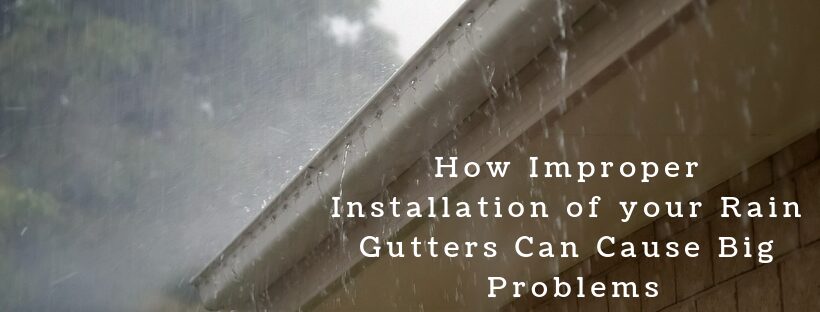If you have rain gutters on your home, it is crucial that you inspect them regularly, as they can cause damage to your structure instead of protecting it.
The damage that rain gutters can produce can be quite costly to repair, so we are going to go over some things to look for. The biggest issues happen when rain gutters are not installed properly, but there are many other factors to keep in mind.
Rain Gutter Inspection
When inspecting a rain gutter system, you will want to look at:
- Gutter size
- Flashing connected to the eaves
- Gutters connection from the roof eaves
- Gutter slope
- Gutter joints
- Gutter holes and/or leaks
- Downspouts
- Splash guards
If you are unsure of what you are looking at, you can contact a reputable company to check it out for you.
Gutter Damage
If you notice any issues with the elements mentioned above, it’s best to get them fixed ASAP. Here’s some more detailed information about what to look out for:
Incorrect Gutter Size
If your gutters are too small for your home, the system will not be able to function correctly. You will need to replace them yourself or have a professional do it for you, after determining the correct size that is required. Houses with steep roofs or those located in climates prone to downpours may need larger gutters and extra downspouts to keep rainwater from overflowing.
When choosing gutter size, it’s a question of simple math. If you have a large roof, it will gather more rainwater. That rainwater will need to have a place to go. Some professionals recommend oversized gutters for every house, as it ensures that no matter what weather you experience, you will be safe.
No or Unconnected Roof Flashing
In a nutshell, flashing is a thin L-shaped metal sheet that is typically used to direct water away from the seams and joints of the roofing systems. When there is either no flashing in place or it has been damaged, the moisture can damage insulation and wood, eventually leading to mildew, dry rot, and/or pest infestations. If there is no flashing, the gutters will need to be taken off and flashing added after checking the wood that is under your roof for damage. If you have flashing that is damaged, you will need to inspect the area and then repair or replace it. This should not be as difficult to correct, as you should not have to take off all of the gutters, just the areas that are affected.
Separation of Gutter Joints
In some cases, gutter joints will pull apart from not being placed together correctly when installed or from too much stress on the gutters from being overloaded. It should not take much to reposition them back into place, but care must be taken not to damage the existing system. Keep in mind that if the gutters have separated due to overloading, it’s wise to look into larger gutters that can accommodate your area’s rain levels.
Holes in the Gutter
Sometimes, holes are formed in gutters from nails that were left from former gutter systems, or they can occur from erosion. If possible, you can patch these areas instead of having to replace the affected section or the entire gutter system.
Misaligned Downspouts
As with the misaligned gutters, if your downspouts are not in their correct positions, they may not be able to control the flow of water out and away from your home. If this is the case, you should reconnect or realign the downspouts.
No Splash Guards
It is critical that you have splash guards in the correct place at the bottom of your downspouts. If they are not in place, rainwater can erode the area at the bottom of the downspout and affect your foundation.
Incorrect Pitch of Rain Gutters
If your gutters do not have the correct pitch toward the downspouts, the water won’t flow as it should. When the water sits within the gutter system, it can create erosion problems. Erosion could occur in the gutters themselves and in your home.
When gutters are not installed properly or maintained regularly, they can affect your home in more ways than just water backup. They can cause roof and structural damage. Water that is not drained away from the foundation of a structure can cause erosion to the ground and damage to the foundation. Foundation issues are a much bigger problem, so it is worth taking preventative measures, like replacing your gutters when necessary.
By taking the time to look not only at your gutters but also at the structure and ground around your home, you can prevent different issues, like standing water and foundation damage, which can end up costing you a significant amount of money to fix.

